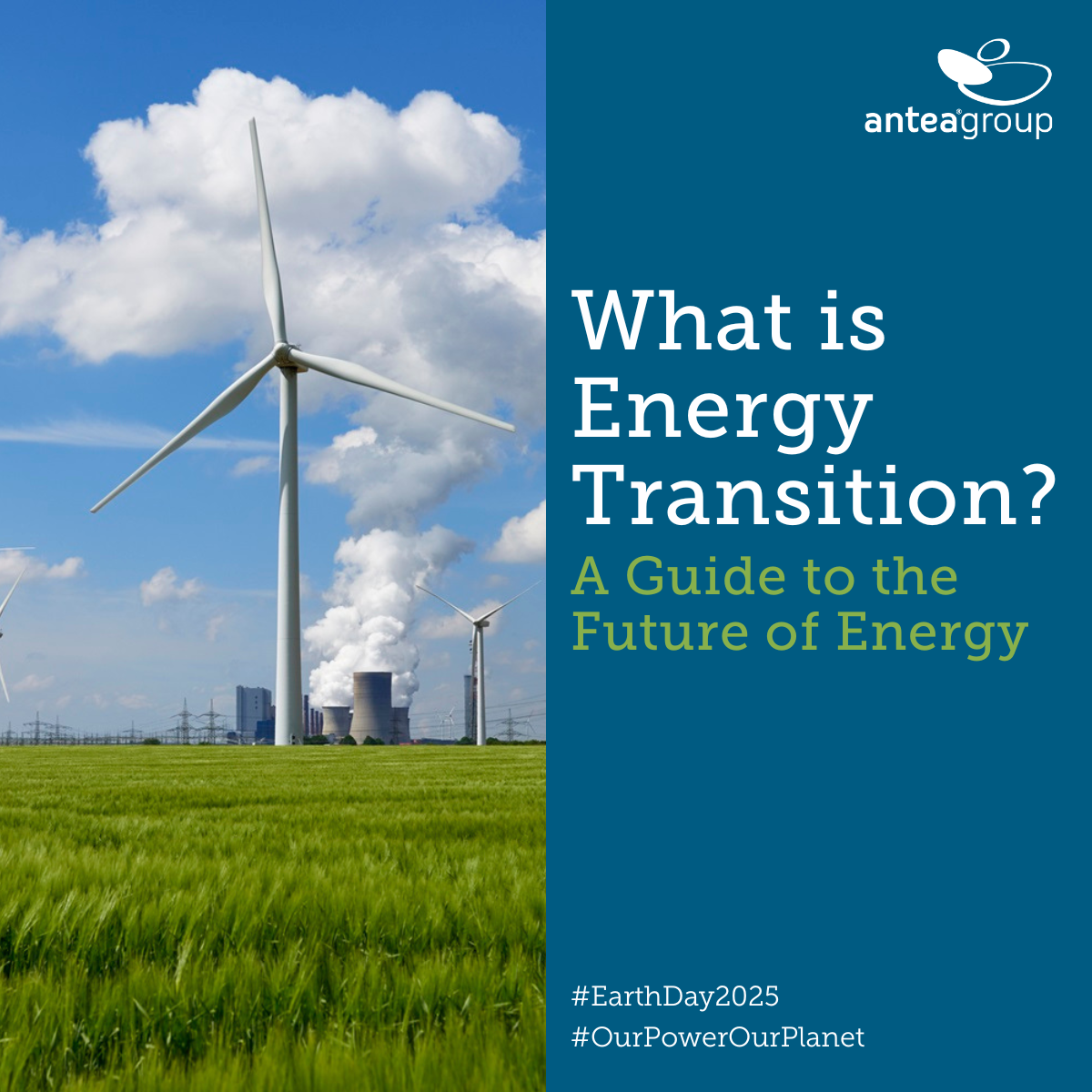What Is Energy Transition? A Guide to the Future of Energy

The shift to cleaner energy sources is vital for reaching climate targets and securing our global energy future. To ensure a smooth transition, businesses, governments and other stakeholder agencies should consider infrastructure needs, policy changes, and fair access for all.
This guide explores the key drivers, emerging trends, and potential impacts of the energy transition, along with insights on how organizations can contribute to a more sustainable future.
What Is Energy Transition?
Energy transition refers to the global shift from fossil fuel-based energy systems to low-carbon and renewable alternatives. This transformation is essential to reducing greenhouse gas emissions and meeting international climate targets, including limiting global warming to 1.5°C above pre-industrial levels as outlined in the Paris Agreement.
Learn more: Energy Transition Explained: Why and How the World Is Making a Shift
The impact of the changing energy mix on infrastructure
The energy mix is shifting as renewables like wind, solar, and hydrogen gain ground. However, fully realizing this transition requires massive infrastructure adaptations.
Power grids, for example, need to be upgraded to handle decentralized and variable renewable energy sources. Additionally, energy storage solutions will need to be expanded to manage supply fluctuations. Finally, existing infrastructure needs to be retrofitted to accommodate low-carbon alternatives such as hydrogen and carbon capture technologies.
When will fossil fuel demand peak?
The International Energy Agency (IEA) predicts that global demand for fossil fuels will peak before 2030, driven by rapid growth in renewables, the rise of electric vehicles, and improving energy efficiency. This forecast signals an accelerated shift away from coal, oil, and natural gas—faster than many previously expected.
However, while demand may decline, strategic planning is essential to ensure a smooth transition, prevent economic shocks, and support workers and communities reliant on fossil fuel industries.
Key Drivers of the Energy Transition
The energy transition is driven by several significant factors, including the critical need to combat climate change and the economic benefits of renewable energy sources. Here’s an overview of the primary drivers moving us toward a greener future.
Combatting climate change
Reducing carbon emissions is at the core of energy transition efforts. Rising global temperatures and increasing climate-related disasters are the most widely felt outcome of climate change, stressing the critical importance of cutting greenhouse gas emissions and accelerating the shift to clean energy sources. Governments, businesses, and investors are working toward aligning strategies with net-zero targets to mitigate long-term climate risks, although shifting political winds risk derailing progress.
Learn more: Safeguarding Businesses from Hurricanes and Wildland Fires
Economic factors
The economic case for clean energy is stronger than ever. The cost of solar and wind power is falling, making renewables more competitive in the broader energy market. Meanwhile, oil and gas markets remain volatile, with geopolitical tensions and supply chain disruptions leading to unpredictable price swings. Many industries are turning to renewables not just for sustainability, but for cost stability and energy security.
Technological innovations
Innovation is accelerating the transition by making clean energy more efficient and scalable. Key breakthroughs include:
- Energy storage improvements: Advancements in battery technology, such as lithium-ion and solid-state batteries, are making renewable energy more reliable.
- Smart grids: Digitalized grids optimize electricity distribution, reduce waste, and enhance energy efficiency.
- Virtual power plants (VPPs): Aggregating distributed energy resources, such as rooftop solar panels and EV chargers, helps balance supply and demand in real time.
The Role of Government and Industry in the Energy Transition
Governments around the world are implementing initiatives that encourage the adoption of clean energy while setting long-term sustainability targets, and public policy and regulatory frameworks play a crucial role in shaping the energy transition. National and international climate commitments, including those under the Paris Agreement, are driving policy shifts toward decarbonization by setting emissions reduction targets.
These regulations also incentivize the business sector to participate in the energy transition. Subsidies, tax credits, and grants for solar, wind, and storage technologies are making clean energy adoption more feasible. Cap-and-trade programs, carbon taxes, and mandatory emissions disclosures are pushing industries to adopt more sustainable energy practices.
While progress varies by region, the momentum behind clean energy policies is undeniable. Companies that proactively align with these regulations will be better positioned for long-term resilience.
Learn more:
- How Business Leaders Are Getting Ready for a Net-Zero World
- Understanding the Crucial Role of Climate Scenario Analysis in Business Strategy
- 5 Steps to be Regulatory Ready: Where Businesses Should Begin
The Economic and Social Impact of Energy Transition
While there are numerous economic and social advantages to energy transition, it is vital that those driving this change take into account how shifting energy infrastructure and workforce needs impacts livelihoods and access to energy.
Capital flow into renewables
Global investment in clean energy has surged in recent years, with the global marketplace investing twice as much in clean energy as it does in fossil fuels.
Major financial institutions, corporations, and governments are channeling capital into wind, solar, hydrogen, and energy storage technologies, with nearly $2 trillion in direct investment since 2020. This shift reflects growing confidence in the long-term viability of renewables and increasing pressure from investors to align with climate goals.
Public and private funding is also expanding to support grid modernization, electric vehicle infrastructure, and emerging clean technologies. However, while investment is accelerating, securing financing for developing economies remains a challenge, requiring targeted policies and international collaboration.
Workforce shifts in a changing energy economy
The transition to clean energy is reshaping the global workforce. While fossil fuel jobs are expected to decline, renewable energy sectors are growing rapidly, creating new employment opportunities in manufacturing, construction, and maintenance.
Sectors seeing significant job expansion include:
- Solar and wind industries, which require large-scale installation and maintenance work.
- Battery production and energy storage, driven by the demand for grid stability and electric vehicles.
- Energy efficiency sectors, such as retrofitting buildings and smart grid deployment.
Despite the growth in clean energy jobs, workforce training and reskilling initiatives are critical to ensuring a just transition for workers moving out of traditional energy sectors.
Energy equity and accessibility
The energy transition presents an opportunity to address energy poverty by expanding access to affordable, reliable electricity in underserved regions. According to the European Commission, “Energy poverty occurs when a household must reduce its energy consumption to a degree that negatively impacts the inhabitants' health and wellbeing.”
Decentralized renewable energy solutions, such as off-grid solar and microgrids, are already transforming energy access in remote and developing communities.
However, ensuring a fair transition means addressing disparities in:
- Infrastructure development, as many regions still lack the resources for large-scale renewable deployment.
- Energy affordability, ensuring that rising energy costs do not disproportionately impact lower-income populations.
- Policy incentives, which must support both industrialized and developing nations in scaling clean energy adoption.
Learn more: Just Energy Transition: The US Perspective
Overcoming barriers to transition
Despite its benefits, the energy transition comes with short-term economic and infrastructure challenges. Key barriers include:
- High upfront costs: While renewables are cost-effective over time, initial investment remains a hurdle. Government incentives and private financing mechanisms play a crucial role in bridging the gap.
- Grid adaptation: Aging infrastructure must be upgraded to accommodate decentralized and intermittent energy sources. Smart grid technologies and energy storage solutions are helping address this challenge.
- Policy and regulatory uncertainty: Inconsistent policies can slow progress. Clear, long-term regulatory frameworks are needed to provide stability for investors and businesses.
While these challenges are significant, the momentum behind the energy transition continues to grow. With strategic planning, investment, and innovation, the shift to a sustainable energy future can drive economic growth, enhance energy security, and create a more equitable global energy system.
The Future of Energy Transition
The future of energy transition holds immense potential. Emerging technologies like AI-driven energy optimization, grid modernization, and advanced storage solutions are transforming the sector, making renewable adoption more efficient and scalable.
Ensuring equitable access to clean energy for all communities is essential, and this demands fair infrastructure development and expanded reach in underserved areas. Businesses and governments play a pivotal role in this endeavor. By adopting sustainable practices and investing in innovative clean energy solutions, they can drive the transition to a cleaner and more resilient energy future for everyone, leaving no one behind.
Ready to lead the energy transition with confidence? Discover how Antea Group’s Energy Management Consulting can help.

